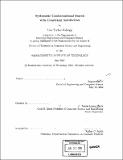| dc.contributor.advisor | Tomás Lozano-Pérez. | en_US |
| dc.contributor.author | Tucker-Kellogg, Lisa, 1969- | en_US |
| dc.contributor.other | Massachusetts Institute of Technology. Dept. of Electrical Engineering and Computer Science. | en_US |
| dc.date.accessioned | 2005-08-24T20:10:41Z | |
| dc.date.available | 2005-08-24T20:10:41Z | |
| dc.date.copyright | 2002 | en_US |
| dc.date.issued | 2002 | en_US |
| dc.identifier.uri | http://hdl.handle.net/1721.1/8081 | |
| dc.description | Thesis (Ph. D.)--Massachusetts Institute of Technology, Dept. of Electrical Engineering and Computer Science, 2002. | en_US |
| dc.description | Includes bibliographical references (p. 170-177). | en_US |
| dc.description.abstract | Determining the conformations of biological molecules is a high scientific priority for biochemists and for the pharmaceutical industry. This thesis describes a systematic method for conformational search, an application of the method to determining the structure of the formyl-Met-Leu-Phe-OH (fMLF)peptide by solid-state NMR spectroscopy, and a separate project to determine the structure of a protein-DNA complex by X-ray crystallography. The purpose of the systematic search method is to enumerate all conformations of a molecule (at a given level of torsion angle resolution) that satisfy a set of local geometric constraints. Constraints would typically come from NMR experiments, but applications such as docking or homology modelling could also give rise to similar constraints. The molecule to be searched is partitioned into small subchains so that the set of possible conformations for the whole molecule may be constructed by merging the feasible conformations for the parts. However, instead of using a binary tree for straightforward divide-and-conquer, four innovations are introduced: (1) OMNIMERGE searches a subproblem for every possible subchain of the molecule. Searching every subchain provides the advantage that every possible merge is available; by choosing the most favorable merge for each subchain, the bottleneck subchain(s) and therefore the whole search may be completed more efficiently. (2) A cost function evaluates alternative divide-and-conquer trees, provided that a preliminary OMNIMERGE search of the molecule has been completed. Then dynamic programming determines the optimal partitioning or "merge-tree" for the molecule; this merge-tree can be used to improve the efficiency of future searches. | en_US |
| dc.description.abstract | (cont.) (3) PROPAGATION shares information by enforcing arc consistency between the solution sets of overlapping subchains. By filtering the solution set of each subchain, infeasible conformations are discarded rapidly. (4) An A* function prioritizes each subchain based on estimated future costs. Subchains with sufficiently low priority can be skipped, which improves efficiency. A common theme of these four ideas is to make good choices about how to break the large search problem into lower-dimensional subproblems. These novel algorithms were implemented and the effectiveness of each is demonstrated on a well-constrained peptide with 40 degrees of freedom. | en_US |
| dc.description.statementofresponsibility | by Lisa Tucker-Kellogg. | en_US |
| dc.format.extent | 178 p. | en_US |
| dc.format.extent | 13121395 bytes | |
| dc.format.extent | 13121150 bytes | |
| dc.format.mimetype | application/pdf | |
| dc.format.mimetype | application/pdf | |
| dc.language.iso | eng | en_US |
| dc.publisher | Massachusetts Institute of Technology | en_US |
| dc.rights | M.I.T. theses are protected by copyright. They may be viewed from this source for any purpose, but reproduction or distribution in any format is prohibited without written permission. See provided URL for inquiries about permission. | en_US |
| dc.rights.uri | http://dspace.mit.edu/handle/1721.1/7582 | |
| dc.subject | Electrical Engineering and Computer Science. | en_US |
| dc.title | Systematic conformational search with constraint satisfaction | en_US |
| dc.type | Thesis | en_US |
| dc.description.degree | Ph.D. | en_US |
| dc.contributor.department | Massachusetts Institute of Technology. Department of Electrical Engineering and Computer Science | |
| dc.identifier.oclc | 51197964 | en_US |
